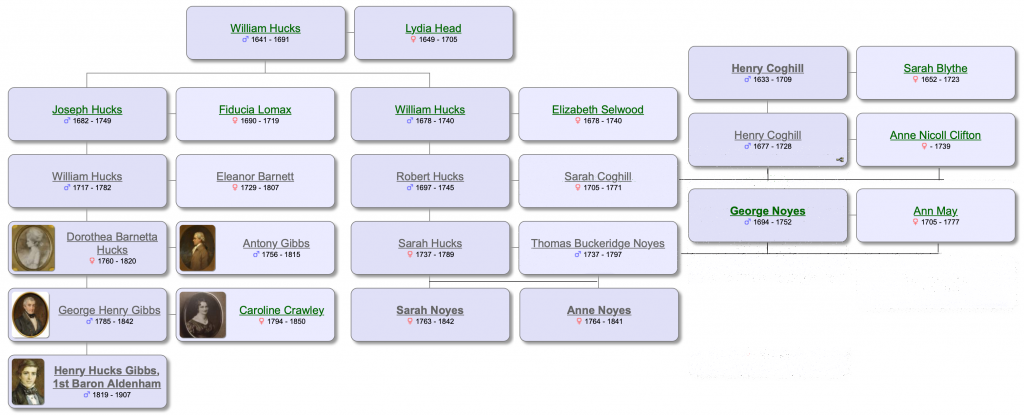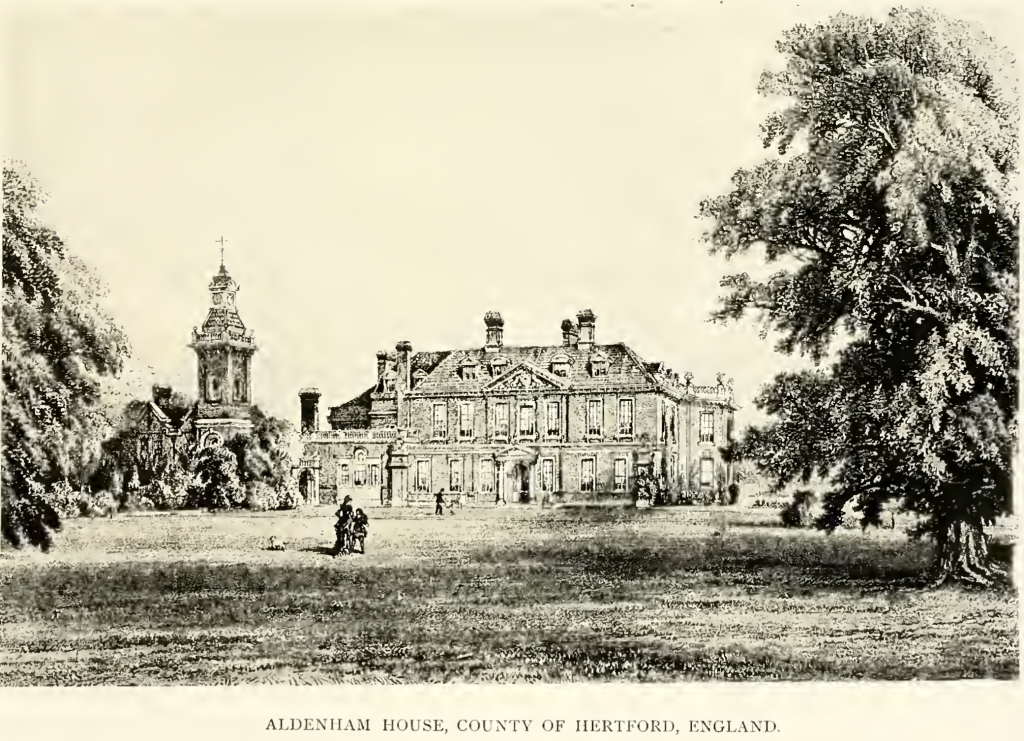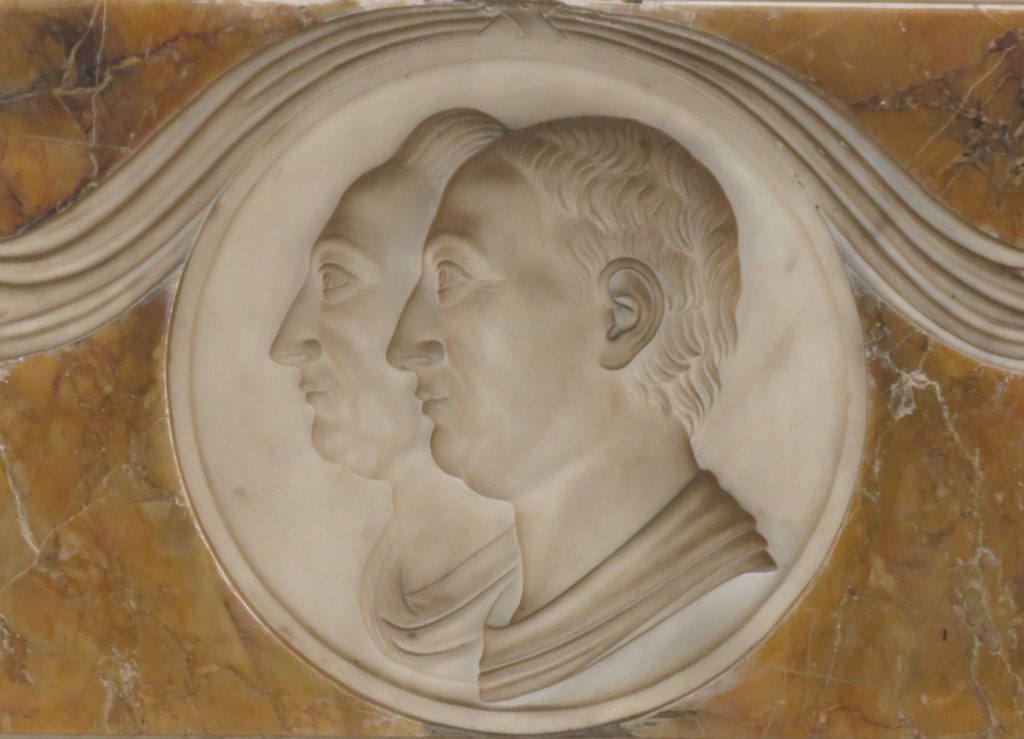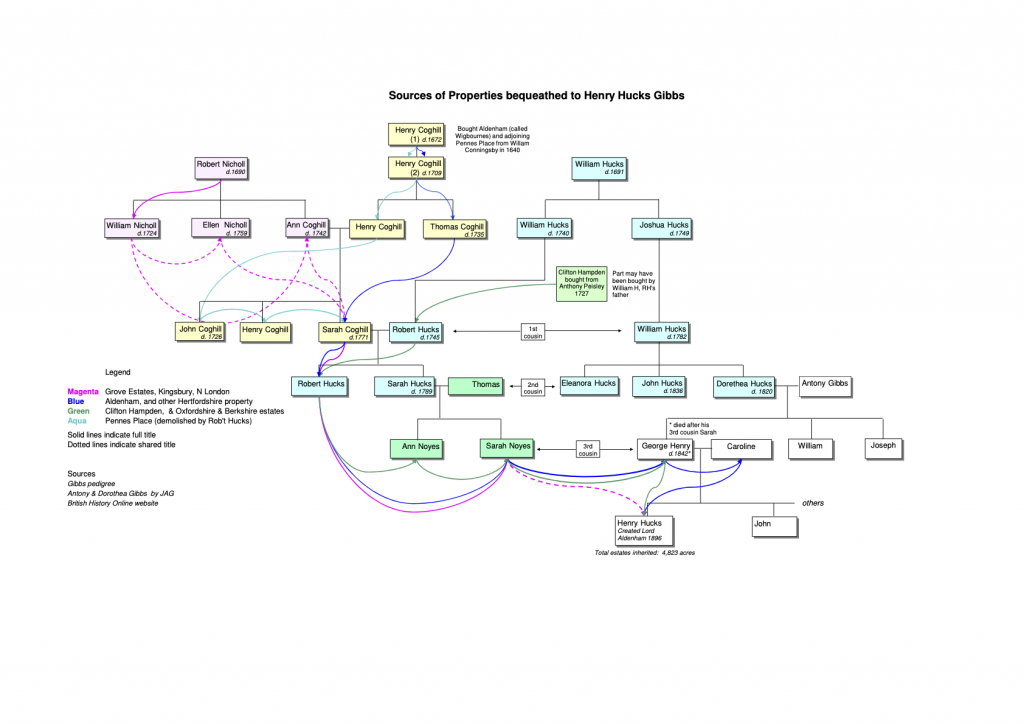Henry Hucks’ fortuitous inheritances and interesting connections
How did Henry Hucks Gibbs (HHG), the 1st Baron Aldenham, come to inherit iconic family estates, including Aldenham House and Clifton Hampden, from a distant 3rd cousin spinster, which had passed down through the Hucks, Noyes, Coghill and Sutton families? A scarcity of heirs and childhood deaths brought these family male lines to an end. The first firm link between the families was Dorothea Barnetta Hucks’ marriage to Antony Gibbs in 1784. “Dolly” was one of thirteen children of which only five attained 21. Originally from Knaresborough, by this age she was the youngest surviving daughter of the Yorkshire wine merchant William Hucks. Her eldest sister Eleanor had married Henry Townley-Ward (from another Yorkshire family going back to the Normans), who was a friend of fellow London solicitor Vicary, Antony’s eldest brother. Vicary was captivated by Dolly, but so was another brother, Abraham, and it was he who courted and became engaged to her!
Tragedy struck in the spring of 1782; Abraham came down with a fever and died a few days later; Dorothea’s father dies shortly after she returned to Yorkshire, and her brother died of consumption in Messina. Recovering from grief at Pytte in Devon, Antony was a great comfort to her and proposed a few months later, postponing their marriage due to his precarious financial position (leading later to bankruptcy and hard times for the newly weds as Antony sought to establish himself in Spain). Much of this is detailed in Chapter II of “The History of Antony and Dorothea Gibbs” by John Arthur Gibbs.

Dorothea’s father’s cousin Robert Hucks, had inherited the family’s brewing fortune. He was elected as Member of Parliament for Abingdon and in 1726 he purchased Clifton Hampton manor (where my grandfather and his father were born). He married Sarah Coghill, daughter of Henry Coghill, inheriting Penne’s Place from her brothers, John and Henry, both of whom died unmarried in their 20s, and Wigbournes estate from her father’s brother. Wigbournes had previously belonged to John Sutton and passed to Henry Coghill’s grandfather Henry through his marriage to Faith Sutton. Wigbournes and Penne’s Place became part of Aldenham House and estate, home to Robert and Sarah Hucks. There is an extensive history of Aldenham on the British History Online website. The story of the Coghill family, originating from Coghill Hall in County of York, was documented by an American descendent James Henry Coghill in 1879, quoting correspondence with HHG.

Their surviving son, also Robert Hucks, was declared a lunatic in 1792, until his death in 1814, and his nieces, Sarah and Anne Noyes, succeeded to his estates. They executed a deed of partition in April, 1815, whereby the Oxfordshire and Berkshire estates, which came from the Hucks family, and land in Lambeth, fell to Anne, and the Hertfordshire, Middlesex, and Cambridgeshire estates, which came from the Coghills, fell to Sarah.
The Noyes sisters were close to their distant Gibbs relatives. When Henry Hucks Gibbs, was born in 1819, Anne Noyes was one of his godparents, and in 1830 she presented Antony Gibbs’ youngest son Joseph with the perpetual curacy of Clifton Hampden. On Sarah’s death intestate in 1842, her estates, including Aldenham House and Clifton Hampden, passed to George Henry Gibbs, only a few months before his own death, and hence on to HHG where Aldenham House became his extensive country residence!
Dorothea’s youngest brother, Joseph Hucks was a great friend of Coleridge and together they did the first of many of Coleridges famous walks (1794). Joseph published an account of this journey “A Pedestrian tour through North Wales“; he mentions visiting a village on the coast of North Wales where he says many of his Hucks/Hux ancestors were buried, with memorials. Joseph was part of the group of poets and writers that advocated the idea of “Pantisocracy” – a vision of “Republic of Reason and Virtue”, ideas that gave America its model for law and their constitution. One of their heroes was Vicary Gibbs who defended some of them from charges of treason.
Sir Christopher Wren the renowned architect of post great-fire London, married his childhood neighbour, Faith Coghill, niece of the older Henry Coghill, in 1669 following his appointment as Surveyor of the King’s Works. She died of smallpox shortly after their son Christopher’ birth in 1675, and mother-in-law, Lady Coghill, arrived to take the infant Christopher back with her to Oxfordshire to raise. The younger Christopher was trained by his father to be an architect and supervised the topping out ceremony of St Paul’s in 1710.
Aldenham Church has a large memorial to Robert Hucks and his wife Sarah, née Coghill, with a lengthy inscription. Also a grand tomb with reclining statues of John Coghill and his wife in the style of Roman nobility; wall panels to the younger lunatic Robert Hucks, and to Henry Townley-Ward and Eleanor. More recent monuments to Lieut. Ronald Gibbs, KIA at Ypres, and a brass to Rev. Kenneth Gibbs, one time Vicar of Aldenham.
Hucks and Coghill ancestor portraits were recovered from Haberdashers’ Aske’s School, Aldenham some years after the school took over the house.

Though the Gibbs family have largely moved on from Aldenham, it remains a place rich with our family history.


Pingback:A Garden to Rival Kew – Gibbs Family Tree
Pingback:Many routes to Jane Austen ? – Gibbs Family Tree